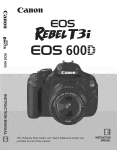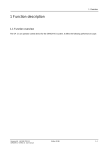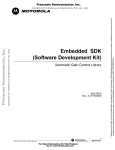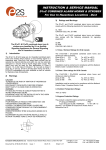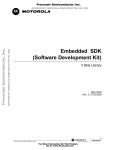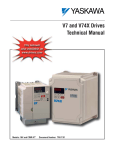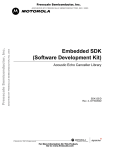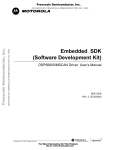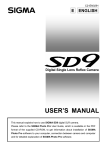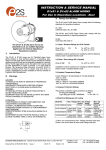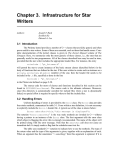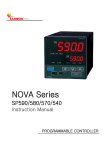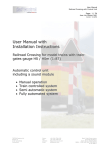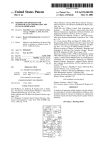Download Embedded SDK (Software Development Kit)
Transcript
Freescale Semiconductor, Inc.
ARCHIVED BY FREESCALE SEMICONDUCTOR, INC. 2005
Freescale Semiconductor, Inc...
ARCHIVED BY FREESCALE SEMICONDUCTOR, INC. 2005
Embedded SDK
(Software Development Kit)
MFCR2 Detection Library
SDK151/D
Rev. 0, 10/24/2002
© Motorola, Inc., 2002. All rights reserved.
For More Information On This Product,
Go to: www.freescale.com
Freescale Semiconductor, Inc.
ARCHIVED BY FREESCALE SEMICONDUCTOR, INC. 2005
Freescale Semiconductor, Inc...
ARCHIVED BY FREESCALE SEMICONDUCTOR, INC. 2005
For More Information On This Product,
Go to: www.freescale.com
Freescale Semiconductor, Inc.
ARCHIVED BY FREESCALE SEMICONDUCTOR, INC. 2005
Contents
About This Document
ARCHIVED BY FREESCALE SEMICONDUCTOR, INC. 2005
Freescale Semiconductor, Inc...
Audience . . . . . . . . . . . . . . . . . . . . . . . . . . . . . . . . . . . . . . . . . . . . . . . . . . . . . . . . .
Organization . . . . . . . . . . . . . . . . . . . . . . . . . . . . . . . . . . . . . . . . . . . . . . . . . . . . . .
Suggested Reading . . . . . . . . . . . . . . . . . . . . . . . . . . . . . . . . . . . . . . . . . . . . . . . . .
Definitions, Acronyms, and Abbreviations . . . . . . . . . . . . . . . . . . . . . . . . . . . . . .
References. . . . . . . . . . . . . . . . . . . . . . . . . . . . . . . . . . . . . . . . . . . . . . . . . . . . . . . .
ix
ix
ix
xi
xi
Chapter 1
Introduction
1.1
1.2
1.2.1
1.2.2
Quick Start . . . . . . . . . . . . . . . . . . . . . . . . . . . . . . . . . . . . . . . . . . . . . . . . . . . . . . . 1-1
Overview of MFCR2 Detection . . . . . . . . . . . . . . . . . . . . . . . . . . . . . . . . . . . . . . . 1-1
Background. . . . . . . . . . . . . . . . . . . . . . . . . . . . . . . . . . . . . . . . . . . . . . . . . . . . 1-1
Features and Performance. . . . . . . . . . . . . . . . . . . . . . . . . . . . . . . . . . . . . . . . . 1-2
Chapter 2
Directory Structure
2.1
2.2
Required Core Directories . . . . . . . . . . . . . . . . . . . . . . . . . . . . . . . . . . . . . . . . . . . 2-1
Optional (Domain-Specific) Directories. . . . . . . . . . . . . . . . . . . . . . . . . . . . . . . . . 2-2
Chapter 3
MFCR2 Detection Library Interfaces
3.1
MFCR2 Detection Services . . . . . . . . . . . . . . . . . . . . . . . . . . . . . . . . . . . . . . . . . . 3-1
3.2
Interface . . . . . . . . . . . . . . . . . . . . . . . . . . . . . . . . . . . . . . . . . . . . . . . . . . . . . . . . . 3-1
3.3
Specifications . . . . . . . . . . . . . . . . . . . . . . . . . . . . . . . . . . . . . . . . . . . . . . . . . . . . . 3-4
3.3.1
MFCR2DetectCreate . . . . . . . . . . . . . . . . . . . . . . . . . . . . . . . . . . . . . . . . . . . . 3-5
3.3.2
MFCR2DetectInit . . . . . . . . . . . . . . . . . . . . . . . . . . . . . . . . . . . . . . . . . . . . . . . 3-8
3.3.3
MFCR2Detect . . . . . . . . . . . . . . . . . . . . . . . . . . . . . . . . . . . . . . . . . . . . . . . . . 3-10
3.3.4
MFCR2DetectDestroy . . . . . . . . . . . . . . . . . . . . . . . . . . . . . . . . . . . . . . . . . . 3-14
Chapter 4
Building the MFCR2 Detection Library
4.1
4.1.1
4.1.2
Building the MFCR2 Detection Library . . . . . . . . . . . . . . . . . . . . . . . . . . . . . . . . . 4-1
Dependency Build. . . . . . . . . . . . . . . . . . . . . . . . . . . . . . . . . . . . . . . . . . . . . . . 4-1
Direct Build. . . . . . . . . . . . . . . . . . . . . . . . . . . . . . . . . . . . . . . . . . . . . . . . . . . . 4-2
MOTOROLA
Table of Contents
For More Information On This Product,
Go to: www.freescale.com
i
Freescale Semiconductor, Inc.
ARCHIVED BY FREESCALE SEMICONDUCTOR, INC. 2005
Chapter 5
Linking Applications with the MFCR2 Detection Library
5.1
5.1.1
MFCR2 Detection Library . . . . . . . . . . . . . . . . . . . . . . . . . . . . . . . . . . . . . . . . . . . 5-1
Library Sections . . . . . . . . . . . . . . . . . . . . . . . . . . . . . . . . . . . . . . . . . . . . . . . . 5-1
Chapter 6
MFCR2 Detection Applications
6.1
Test and Demo Applications. . . . . . . . . . . . . . . . . . . . . . . . . . . . . . . . . . . . . . . . . . 6-1
7.1
Limited Use License Agreement . . . . . . . . . . . . . . . . . . . . . . . . . . . . . . . . . . . . . . 7-1
ARCHIVED BY FREESCALE SEMICONDUCTOR, INC. 2005
Freescale Semiconductor, Inc...
Chapter 7
License
ii
MFCR2 Detection Library
For More Information On This Product,
Go to: www.freescale.com
MOTOROLA
Freescale Semiconductor, Inc.
ARCHIVED BY FREESCALE SEMICONDUCTOR, INC. 2005
List of Tables
MFCR2DetectCreate Arguments . . . . . . . . . . . . . . . . . . . . . . . . . . . . . . . . . . . . 3-5
MFCR2DetectInit Arguments. . . . . . . . . . . . . . . . . . . . . . . . . . . . . . . . . . . . . . . 3-8
,MFCR2Detect Arguments . . . . . . . . . . . . . . . . . . . . . . . . . . . . . . . . . . . . . . . . 3-10
MFCR2DetectDestroy Arguments . . . . . . . . . . . . . . . . . . . . . . . . . . . . . . . . . . 3-14
ARCHIVED BY FREESCALE SEMICONDUCTOR, INC. 2005
Freescale Semiconductor, Inc...
Table 3-1
Table 3-2
Table 3-3
Table 3-4
MOTOROLA
List of Tables
For More Information On This Product,
Go to: www.freescale.com
iii
Freescale Semiconductor, Inc.
ARCHIVED BY FREESCALE SEMICONDUCTOR, INC. 2005
Freescale Semiconductor, Inc...
ARCHIVED BY FREESCALE SEMICONDUCTOR, INC. 2005
iv
MFCR2 Detection Library
For More Information On This Product,
Go to: www.freescale.com
MOTOROLA
Freescale Semiconductor, Inc.
ARCHIVED BY FREESCALE SEMICONDUCTOR, INC. 2005
List of Figures
Core Directories . . . . . . . . . . . . . . . . . . . . . . . . . . . . . . . . . . . . . . . . . . . . . . . . .
DSP568XX Directories. . . . . . . . . . . . . . . . . . . . . . . . . . . . . . . . . . . . . . . . . . . .
Mfcr2 Directory Structure . . . . . . . . . . . . . . . . . . . . . . . . . . . . . . . . . . . . . . . . .
Dependency Build for MFCR2 Detection Library . . . . . . . . . . . . . . . . . . . . . . .
MFCR2 Detection Project . . . . . . . . . . . . . . . . . . . . . . . . . . . . . . . . . . . . . . . . .
Execute Make . . . . . . . . . . . . . . . . . . . . . . . . . . . . . . . . . . . . . . . . . . . . . . . . . . .
2-1
2-2
2-3
4-1
4-2
4-2
ARCHIVED BY FREESCALE SEMICONDUCTOR, INC. 2005
Freescale Semiconductor, Inc...
Figure 2-1
Figure 2-2
Figure 2-3
Figure 4-1
Figure 4-2
Figure 4-3
MOTOROLA
List of Figures
For More Information On This Product,
Go to: www.freescale.com
v
Freescale Semiconductor, Inc.
ARCHIVED BY FREESCALE SEMICONDUCTOR, INC. 2005
Freescale Semiconductor, Inc...
ARCHIVED BY FREESCALE SEMICONDUCTOR, INC. 2005
vi
MFCR2 Detection Library
For More Information On This Product,
Go to: www.freescale.com
MOTOROLA
Freescale Semiconductor, Inc.
ARCHIVED BY FREESCALE SEMICONDUCTOR, INC. 2005
Code Example
Code Example
Code Example
Code Example
Code Example
Code Example
Code Example
3-1
3-2
3-3
3-4
3-5
3-6
5-1
C Header File MFCR2Detect.h . . . . . . . . . . . . . . . . . . . . . . . . . . . . . . . 3-1
mem Library . . . . . . . . . . . . . . . . . . . . . . . . . . . . . . . . . . . . . . . . . . . . . . 3-5
Use of MFCR2DetectCreate Interface . . . . . . . . . . . . . . . . . . . . . . . . . . 3-7
Use of MFCR2DetectInit Interface. . . . . . . . . . . . . . . . . . . . . . . . . . . . . 3-8
Use of MFCR2Detect Interface . . . . . . . . . . . . . . . . . . . . . . . . . . . . . . 3-12
Use of MFCR2DetectDestroy Interface . . . . . . . . . . . . . . . . . . . . . . . . 3-14
linker.cmd File . . . . . . . . . . . . . . . . . . . . . . . . . . . . . . . . . . . . . . . . . . . . 5-1
ARCHIVED BY FREESCALE SEMICONDUCTOR, INC. 2005
Freescale Semiconductor, Inc...
List of Examples
MOTOROLA
List of Examples
For More Information On This Product,
Go to: www.freescale.com
vii
Freescale Semiconductor, Inc.
ARCHIVED BY FREESCALE SEMICONDUCTOR, INC. 2005
Freescale Semiconductor, Inc...
ARCHIVED BY FREESCALE SEMICONDUCTOR, INC. 2005
viii
MFCR2 Detection Library
For More Information On This Product,
Go to: www.freescale.com
MOTOROLA
Freescale Semiconductor, Inc.
ARCHIVED BY FREESCALE SEMICONDUCTOR, INC. 2005
About This Document
This manual describes the Multi-Frequency Compelled R2 (MFCR2) Detection algorithm for use with
Motorola’s Embedded Software Development Kit, (SDK).
This document targets software developers implementing MFCR2 Detection within software applications.
ARCHIVED BY FREESCALE SEMICONDUCTOR, INC. 2005
Freescale Semiconductor, Inc...
Audience
Organization
This manual is arranged in the following sections:
•
•
•
•
•
•
•
Chapter 1, Introduction —provides a brief overview of this document
Chapter 2, Directory Structure —provides a description of the required core directories
Chapter 3, MFCR2 Detection Library Interfaces —describes all of the MFCR2 Detection
Library functions
Chapter 4, Building the MFCR2 Detection Library —tells how to execute the system library
project build
Chapter 5, Linking Applications with the MFCR2 Detection Library —describes organization
of the MFCR2 Detection Library
Chapter 6, MFCR2 Detection Applications —describes the use of MFCR2 Detection Library
through test applications
Chapter 7, License —provides the license required to use this product
Suggested Reading
We recommend that you have a copy of the following references:
•
•
•
•
Motorola DSP56800 Family Manual, DSP56800FM/AD
Motorola DSP56800E Reference Manual, DSP56800ERM/D
Motorola DSP568xx User’s Manual, for the DSP device you’re implementing
Inside CodeWarrior: Core Tools, Metrowerks Corp.
MOTOROLA
Preface
For More Information On This Product,
Go to: www.freescale.com
ix
Freescale Semiconductor, Inc.
ARCHIVED BY FREESCALE SEMICONDUCTOR, INC. 2005
Conventions
This document uses the following notational conventions:
ARCHIVED BY FREESCALE SEMICONDUCTOR, INC. 2005
Freescale Semiconductor, Inc...
Typeface,
Symbol or Term
Meaning
Examples
Courier
Monospaced
Type
Code examples
//Process command for line flash
Italic
Directory names,
project names,
calls,
functions,
statements,
procedures,
routines,
arguments,
file names,
applications,
variables,
directives,
code snippets
APIs
in text
...and contains these core directories:
applications contains applications software...
Bold
Reference sources,
paths,
emphasis
...refer to the Targeting DSP56F80x Platform
manual....
...see: C:\Program Files\Motorola\Embedded
SDK\help\tutorials
Blue Text
Linkable on-line
...refer to Chapter 7, License....
Number
Any number is considered a
positive value, unless preceded
by a minus symbol to signify a
negative value
3V
-10
DES-1
ALL CAPITAL
LETTERS
# defines/
defined constants
# define INCLUDE_STACK_CHECK
Brackets [...]
Function keys
...by pressing function key [F7]
Quotation
marks, “...”
Returned messages
...the message, “Test Passed” is displayed....
...CodeWarrior project, 3des.mcp is...
...the pConfig argument....
...defined in the C header file, aec.h....
...if unsuccessful for any reason, it will return
“NULL”...
x
MFCR2 Detection Library
For More Information On This Product,
Go to: www.freescale.com
MOTOROLA
Freescale Semiconductor, Inc.
ARCHIVED BY FREESCALE SEMICONDUCTOR, INC. 2005
Definitions, Acronyms, and Abbreviations
ARCHIVED BY FREESCALE SEMICONDUCTOR, INC. 2005
Freescale Semiconductor, Inc...
The following list defines the acronyms and abbreviations used in this document. As this template
develops, this list will be generated from the document. As we develop more group resources, these
acronyms will be easily defined from a common acronym dictionary. Please note that while the acronyms
are in solid caps, terms in the definition should be initial capped ONLY IF they are trademarked names or
proper nouns.
DSP
Digital Signal Processor or Digital Signal Processing
I/O
Input/Output
IDE
Integrated Development Environment
MFCR2
Multi-Frequency Compelled Register Signaling
MIPS
Million Instructions Per Second
OnCE™
On-Chip Emulation
SDK
Software Development Kit
SRC
Source
References
The following sources were used to produce this book:
1.
2.
3.
4.
5.
Motorola DSP56800 Family Manual, DSP56800FM/AD
Motorola DSP56800E Reference Manual, DSP56800ERM/D
Motorola DSP568xx User’s Manual, for the DSP device you’re implementing
Targeting Motorola DSP568xx Platform, for the DSP device you’re implementing
Motorola Embedded SDK Programmer’s Guide, SDK101/D
MOTOROLA
Preface
For More Information On This Product,
Go to: www.freescale.com
xi
Freescale Semiconductor, Inc.
ARCHIVED BY FREESCALE SEMICONDUCTOR, INC. 2005
Freescale Semiconductor, Inc...
ARCHIVED BY FREESCALE SEMICONDUCTOR, INC. 2005
xii
MFCR2 Detection Library
For More Information On This Product,
Go to: www.freescale.com
MOTOROLA
Freescale Semiconductor, Inc.
ARCHIVED BY FREESCALE SEMICONDUCTOR, INC. 2005
Welcome to Motorola’s Family of Digital Signal Processors (DSPs). This document describes the
Multi-Frequency Compelled R2 (MFCR2) Detection Library, which is a part of Motorola’s comprehensive
Software Development Kit (SDK) for its DSPs. In this document, you will find all the information required
to use and maintain the MFCR2 Detection Library interface and algorithms.
ARCHIVED BY FREESCALE SEMICONDUCTOR, INC. 2005
Freescale Semiconductor, Inc...
Chapter 1
Introduction
Motorola provides these algorithms to you for use with Motorola DSPs to expedite your application
development and reduce the time it takes to bring your own products to market.
Motorola’s MFCR2 Detection Library is licensed for your use on Motorola processors. Please refer to the
standard Software License Agreement in Chapter 7 for license terms and conditions; please consult with
your Motorola representative for premium product licensing.
1.1 Quick Start
Motorola Embedded SDK is targeted to a large variety of hardware platforms. To take full advantage of a
particular hardware platform, use Quick Start from the Targeting DSP568xx Platform documentation.
For example, the Targeting DSP56826 Platform manual provides more specific information and
examples about this hardware architecture. If you are developing an application for the DSP56826EVM
board or any other DSP56826 development system, refer to the Targeting DSP56826 Platform manual
for Quick Start or other DSP56826-specific information.
1.2 Overview of MFCR2 Detection
During the exchange of multi-frequency combinations the link or multi-link section is terminated at both
ends by equipment allowing multi-frequency combinations to be sent and received under mutual,
compelled control, as indicated in Recommendation Q.440 of ITU-T. The MFCR2 library implements the
receiving function of the multi-frequency signaling equipment.
1.2.1 Background
The composition of the multi-frequency combinations is specified in Recommendation Q.441 of ITU-T.
MOTOROLA
Introduction
For More Information On This Product,
Go to: www.freescale.com
1-1
Introduction
Freescale Semiconductor, Inc.
ARCHIVED BY FREESCALE SEMICONDUCTOR, INC. 2005
The frequencies in the forward direction are:
•
•
•
•
•
•
f0 = 1380Hz
f1 = 1500Hz
f2 = 1620Hz
f3 = 1740Hz
f4 = 1860Hz
f5 = 1980Hz
ARCHIVED BY FREESCALE SEMICONDUCTOR, INC. 2005
Freescale Semiconductor, Inc...
The frequencies in the backward direction are:
•
•
•
•
•
•
f0 = 1140Hz
f1 = 1020Hz
f2 = 900Hz
f3 = 780Hz
f4 = 660Hz
f5 = 540Hz
1.2.2 Features and Performance
MFCR2 Detection is multi-channel and re-entrant.
For details on memory and MIPS for a particular DSP, refer to the Libraries chapter of the appropriate
Targeting manual.
1-2
MFCR2 Detection Library
For More Information On This Product,
Go to: www.freescale.com
MOTOROLA
Freescale Semiconductor, Inc.
ARCHIVED BY FREESCALE SEMICONDUCTOR, INC. 2005
2.1 Required Core Directories
ARCHIVED BY FREESCALE SEMICONDUCTOR, INC. 2005
Freescale Semiconductor, Inc...
Chapter 2
Directory Structure
Figure 2-1 details required platform directories:
src
dsp568XXevm
nos
+
applications
+
bsp
config
include
+
sys
+
tools
Figure 2-1. Core Directories
In Figure 2-1, DSP568XXEVM has no operating system (nos) support and contains these core directories:
•
•
•
•
•
•
applications contains applications software that can be exercised on this platform
bsp contains board support package specific for this platform
config contains default HW/SW configuration for this platform
include contains SDK header files which define the Application Programming Interface
sys contains required system components
tools contains utilities used by system components
There are also optional directories that include domain-specific libraries.
MOTOROLA
Directory Structure
For More Information On This Product,
Go to: www.freescale.com
2-1
Directory Structure
Freescale Semiconductor, Inc.
ARCHIVED BY FREESCALE SEMICONDUCTOR, INC. 2005
2.2 Optional (Domain-Specific) Directories
Figure 2-2 demonstrates how the MFCR2 Detection algorithm, Mfcr2, is encapsulated in the domainspecific directory telephony.
src
dsp568XXevm
+
applications
+
bsp
config
include
ARCHIVED BY FREESCALE SEMICONDUCTOR, INC. 2005
Freescale Semiconductor, Inc...
nos
+
modem
+
security
+
signal
+
speech
+
sys
telephony
+
+
+
aec
+
caller_id
+
+
cas_detect
cpt
+
ctg
+
dtmf_det
+
dtmf_gen
+
g165
+
g168
+
g711
+
g723
+
g726
+
Mfcr2
+
vad
tools
Figure 2-2. DSP568XX Directories
2-2
MFCR2 Detection Library
For More Information On This Product,
Go to: www.freescale.com
MOTOROLA
Freescale Semiconductor,
Inc.
Optional (Domain-Specific) Directories
ARCHIVED BY FREESCALE SEMICONDUCTOR, INC. 2005
The Mfcr2 directory includes MFCR2 Detection-specific algorithms. Figure 2-3 shows the Mfcr2
directory structure.
+
g726
Mfcr2
asm_sources
c_sources
test
c_sources
inputs
ARCHIVED BY FREESCALE SEMICONDUCTOR, INC. 2005
Freescale Semiconductor, Inc...
Config
Figure 2-3. Mfcr2 Directory Structure
The Mfcr2 directory includes these sub-directories:
•
•
•
asm_sources includes all assembly source files
c_sources includes C source files providing a C-callable API for MFCR2 Detection
test includes C source files and configuration necessary for testing MFCR2 Detection library
modules
— c_sources contains test code used to confirm correct operation of the MFCR2 Detection
library
— Config contains configuration files appconfig.c, appconfig.h and linker.cmd specific to MFCR2
Detection testing
— inputs contains the test input files
MOTOROLA
Directory Structure
For More Information On This Product,
Go to: www.freescale.com
2-3
Directory Structure
Freescale Semiconductor, Inc.
ARCHIVED BY FREESCALE SEMICONDUCTOR, INC. 2005
Freescale Semiconductor, Inc...
ARCHIVED BY FREESCALE SEMICONDUCTOR, INC. 2005
2-4
MFCR2 Detection Library
For More Information On This Product,
Go to: www.freescale.com
MOTOROLA
Freescale Semiconductor, Inc.
ARCHIVED BY FREESCALE SEMICONDUCTOR, INC. 2005
3.1 MFCR2 Detection Services
ARCHIVED BY FREESCALE SEMICONDUCTOR, INC. 2005
Freescale Semiconductor, Inc...
Chapter 3
MFCR2 Detection Library Interfaces
The MFCR2 signal consists of two frequencies taken either from the set of six forward frequencies or from
the set of six backward frequencies. The MFCR2 receiver must detect any valid MFCR2 tone and output
the numerical value corresponding to that tone.
3.2 Interface
The C interface for the MFCR2 Detection library service is defined in the C header file MFCR2Detect.h,
shown in Code Example 3-1.
Code Example 3-1. C Header File MFCR2Detect.h
/* File: MFCR2Detect.h */
#ifndef __MFCR2DETECT_H
#define __MFCR2DETECT_H
/***************************
Foundational Include Files
****************************/
#include "port.h"
/**************************************
#defines to be used to configure MFCR2
*************************************/
/* These #defines should be used by the user to initialize the configuration
structure.*/
#define MFCR2_FORWARD
#define MFCR2_BACKWARD
MOTOROLA
0x0000
0x0001
MFCR2 Detection Library Interfaces
For More Information On This Product,
Go to: www.freescale.com
3-1
Freescale Semiconductor, Inc.
MFCR2 Detection Library Interfaces
ARCHIVED BY FREESCALE SEMICONDUCTOR, INC. 2005
/***************************
Errors returned by MFCR2
**************************/
#define MFCR2_INVALID
0x8000
ARCHIVED BY FREESCALE SEMICONDUCTOR, INC. 2005
Freescale Semiconductor, Inc...
/***************************
Status returned by MFCR2
**************************/
#define
#define
#define
#define
#define
#define
#define
#define
#define
#define
#define
#define
#define
#define
#define
MFCR2_SIGNAL1_DETECTED
MFCR2_SIGNAL2_DETECTED
MFCR2_SIGNAL3_DETECTED
MFCR2_SIGNAL4_DETECTED
MFCR2_SIGNAL5_DETECTED
MFCR2_SIGNAL6_DETECTED
MFCR2_SIGNAL7_DETECTED
MFCR2_SIGNAL8_DETECTED
MFCR2_SIGNAL9_DETECTED
MFCR2_SIGNAL10_DETECTED
MFCR2_SIGNAL11_DETECTED
MFCR2_SIGNAL12_DETECTED
MFCR2_SIGNAL13_DETECTED
MFCR2_SIGNAL14_DETECTED
MFCR2_SIGNAL15_DETECTED
0x0001
0x0002
0x0003
0x0004
0x0005
0x0006
0x0007
0x0008
0x0009
0x000a
0x000b
0x000c
0x000d
0x000e
0x000f
#define
#define
#define
#define
#define
#define
#define
#define
#define
#define
#define
#define
#define
#define
#define
MFCR2_STOP_DETECTED_WITH_SIGNAL1
MFCR2_STOP_DETECTED_WITH_SIGNAL2
MFCR2_STOP_DETECTED_WITH_SIGNAL3
MFCR2_STOP_DETECTED_WITH_SIGNAL4
MFCR2_STOP_DETECTED_WITH_SIGNAL5
MFCR2_STOP_DETECTED_WITH_SIGNAL6
MFCR2_STOP_DETECTED_WITH_SIGNAL7
MFCR2_STOP_DETECTED_WITH_SIGNAL8
MFCR2_STOP_DETECTED_WITH_SIGNAL9
MFCR2_STOP_DETECTED_WITH_SIGNAL10
MFCR2_STOP_DETECTED_WITH_SIGNAL11
MFCR2_STOP_DETECTED_WITH_SIGNAL12
MFCR2_STOP_DETECTED_WITH_SIGNAL13
MFCR2_STOP_DETECTED_WITH_SIGNAL14
MFCR2_STOP_DETECTED_WITH_SIGNAL15
0x0031
0x0032
0x0033
0x0034
0x0035
0x0036
0x0037
0x0038
0x0039
0x003a
0x003b
0x003c
0x003d
0x003e
0x003f
/**********************************************
MFCR2_BUSY is returned when the processing
is still going on. Otherwise returned value
would indicate the tone detected or error
**********************************************/
#define MFCR2_BUSY
0x0000
/********************************************
Structure for MFCR2 Detect Handle
*********************************************/
typedef struct
{
3-2
MFCR2 Detection Library
For More Information On This Product,
Go to: www.freescale.com
MOTOROLA
Freescale Semiconductor, Inc.
Interface
ARCHIVED BY FREESCALE SEMICONDUCTOR, INC. 2005
Int16 *In_Context_buf;
UInt16 context_buf_length;
Word16 *MFCR2_DATAStruct;
Frac16 *Circular_Buffer;
Frac16 *Copy_Filter_Coefs; /* Should be allocated in internal memory. */
}MFCR2_sHandle;
typedef struct
{
Int16 DIRECTION;
ARCHIVED BY FREESCALE SEMICONDUCTOR, INC. 2005
Freescale Semiconductor, Inc...
/********************************************************
Structure for MFCR2 Detect Configuration
to be used by the user. Use the #defines
MFCR2_FORWARD or MFCR2_BACKWARD defined in
this file
********************************************************/
}MFCR2_sConfigure;
/********************************
MFCR2 Detect Function Prototypes
*********************************/
EXPORT MFCR2_sHandle * MFCR2DetectCreate (MFCR2_sConfigure *pConfig);
EXPORT void MFCR2DetectInit (MFCR2_sHandle *pMFCR2Detect, MFCR2_sConfigure
*pConfig);
EXPORT Result MFCR2Detect (MFCR2_sHandle *pMFCR2Detect,
Int16 *pSamples,
UInt16 NumSamples);
EXPORT void MFCR2DetectDestroy (MFCR2_sHandle *pMFCR2Detect);
/*******************************************************
Constants used by the detect algorithm. User should not
change this constant value
******************************************************/
#define FRAME_SZ 32
#endif
MOTOROLA
MFCR2 Detection Library Interfaces
For More Information On This Product,
Go to: www.freescale.com
3-3
Freescale Semiconductor, Inc.
MFCR2 Detection Library Interfaces
ARCHIVED BY FREESCALE SEMICONDUCTOR, INC. 2005
3.3 Specifications
The following pages describe the MFCR2 Detection library functions.
Function arguments for each routine are described as in, out, or inout. An in argument means that the
parameter value is an input only to the function. An out argument means that the parameter value is an
output only from the function. An inout argument means that a parameter value is an input to the function,
but the same parameter is also an output from the function.
ARCHIVED BY FREESCALE SEMICONDUCTOR, INC. 2005
Freescale Semiconductor, Inc...
Typically, inout parameters are input pointer variables in which the caller passes the address of a
preallocated data structure to a function. The function stores its results within that data structure. The
actual value of the inout pointer parameter is not changed.
3-4
MFCR2 Detection Library
For More Information On This Product,
Go to: www.freescale.com
MOTOROLA
Freescale Semiconductor, Inc.
Specifications
ARCHIVED BY FREESCALE SEMICONDUCTOR, INC. 2005
3.3.1 MFCR2DetectCreate
Call(s):
MFCR2_sHandle * MFCR2DetectCreate (MFCR2_sConfigure *pConfig);
Required Header: “MFCR2Detect.h”, “mem.h”
Arguments:
Table 3-1. MFCR2DetectCreate Arguments
ARCHIVED BY FREESCALE SEMICONDUCTOR, INC. 2005
Freescale Semiconductor, Inc...
pConfig
in
Points to the configuration data for MFCR2 Detection
Description: The MFCR2 function creates an instance of MFCR2 Detection; 216 words are dynamically
allocated per instance, and multiple instances are possible. The pConfig argument points to a
MFCR2_sConfigure structure, which configures MFCR2 Detection operation. Before calling
MFCR2DetectCreate, the user must initialize the DIRECTION parameter in the pConfig structure to either
MFCR2_FORWARD or MFCR2_BACKWARD, depending on whether the input is going to be a forward
frequency combination or a backward frequency combination. The function MFCR2DetectCreate itself
calls the initialization function, MFCR2DetectInit. The library dynamically allocates memory using the
mem library, as shown in Code Example 3-2.
Code Example 3-2. mem Library
#include "mem.h"
#include "MFCR2Detect.h"
MFCR2_sHandle *MFCR2DetectCreate (MFCR2_sConfigure *pConfig)
{
MFCR2_sHandle *pMFCR2Detect;
/* Allocate the memory for the handle structure*/
pMFCR2Detect = (MFCR2_sHandle *) memMallocEM (
sizeof (MFCR2_sHandle));
if (pMFCR2Detect == NULL) return (NULL);
/* Allocate memory for the MFCR2datastruct */
pMFCR2Detect->MFCR2_DATAStruct = (Word16 *) memMallocIM (
110 * sizeof (Word16));
if ((pMFCR2Detect->MFCR2_DATAStruct == NULL) ||
(memIsIM (pMFCR2Detect->MFCR2_DATAStruct) == false))
{
MFCR2DetectDestroy (pMFCR2Detect);
return (NULL);
}
/* Allocate memory for the Copy Filter coefs in the Internal memory */
pMFCR2Detect->Copy_Filter_Coefs = (Word16 *) memMallocIM (
10 * sizeof (Word16));
if ((pMFCR2Detect->Copy_Filter_Coefs == NULL) ||
(memIsIM (pMFCR2Detect->Copy_Filter_Coefs) == false))
{
MOTOROLA
MFCR2 Detection Library Interfaces
For More Information On This Product,
Go to: www.freescale.com
3-5
Freescale Semiconductor, Inc.
MFCR2 Detection Library Interfaces
ARCHIVED BY FREESCALE SEMICONDUCTOR, INC. 2005
MFCR2DetectDestroy (pMFCR2Detect);
return (NULL);
}
/* Allocate memory for the Circular buffer of size 64 */
pMFCR2Detect->Circular_Buffer =
(Frac16 *) memMallocAlignedEM (64 * sizeof (Frac16));
if ((pMFCR2Detect->Circular_Buffer == NULL) ||
(memIsAligned (pMFCR2Detect->Circular_Buffer,(64 * sizeof(Frac16))) == false))
{
MFCR2DetectDestroy (pMFCR2Detect);
return (NULL);
/* Allocate memory for the In_Context_buf */
ARCHIVED BY FREESCALE SEMICONDUCTOR, INC. 2005
Freescale Semiconductor, Inc...
}
pMFCR2Detect->In_Context_buf = (Int16 *) memMallocEM (FRAME_SZ * sizeof(Int16));
if (pMFCR2Detect->In_Context_buf == NULL)
{
MFCR2DetectDestroy (pMFCR2Detect);
return (NULL);
}
MFCR2DetectInit (pMFCR2Detect, pConfig);
return (pMFCR2Detect);
}
For details on the MFCR2_sHandle structure, please refer to Code Example 3-1.
If the MFCR2DetectCreate function is called to create an instance, then MFCR2DetectDestroy, discussed
in Section 3.3.4, should be used to destroy the instance.
Alternatively, the user can allocate memory statically, which requires duplicating all statements in the
MFCR2DetectCreate function. In this case, the user can call the MFCR2DetectInit function directly,
bypassing the MFCR2DetectCreate function. If the user dynamically allocates memory without calling
MFCR2DetectCreate, then the user himself must destroy the memory allocated.
Returns: A pointer to an instance of MFCR2 Detection.
Special Considerations:
•
3-6
If MFCR2DetectCreate is called, then the user need not call the MFCR2DetectInit function, as it is
called internally in the MFCR2DetectCreate function.
MFCR2 Detection Library
For More Information On This Product,
Go to: www.freescale.com
MOTOROLA
Freescale Semiconductor, Inc.
Specifications
ARCHIVED BY FREESCALE SEMICONDUCTOR, INC. 2005
Code Example 3-3. Use of MFCR2DetectCreate Interface
#include "MFCR2Detect.h"
void testMFCR2DetectCreate (void)
{
MFCR2_sHandle *pMFCR2Detect;
MFCR2_sConfigure pConfig;
/* Initialize the pConfig structure */
pConfig.DIRECTION = MFCR2_BACKWARD;
....
ARCHIVED BY FREESCALE SEMICONDUCTOR, INC. 2005
Freescale Semiconductor, Inc...
pMFCR2Detect = MFCR2DetectCreate(&pConfig);
if (pMFCR2Detect == NULL) assert(!"Cannot allocate memory");
}
MOTOROLA
MFCR2 Detection Library Interfaces
For More Information On This Product,
Go to: www.freescale.com
3-7
Freescale Semiconductor, Inc.
MFCR2 Detection Library Interfaces
ARCHIVED BY FREESCALE SEMICONDUCTOR, INC. 2005
3.3.2 MFCR2DetectInit
Call(s):
void MFCR2DetectInit (MFCR2_sHandle *pMFCR2Detect,
MFCR2_sConfigure *pConfig)
Required Header: “MFCR2Detect.h”
Arguments:
ARCHIVED BY FREESCALE SEMICONDUCTOR, INC. 2005
Freescale Semiconductor, Inc...
Table 3-2. MFCR2DetectInit Arguments
pMFCR2Detect
in
Handle to an instance of MFCR2 Detection
pConfig
in
A pointer to a data structure containing data for initializing the MFCR2
Detection algorithm
Description: The MFCR2DetectInit function initializes the MFCR2 Detection algorithm. During
initialization, all resources will be set to their initial values in preparation for MFCR2 Detection operation.
The parameter pConfig points to a data structure of type MFCR2_sConfigure; the MFCR2DetectInit
function initializes the filter states, filter coefficients and other parameters used for MFCR2 detection.
Returns: None
Special Considerations:
•
If MFCR2DetectCreate is called, then the user need not call the MFCR2DetectInit function, which
is called internally in the MFCR2DetectCreate function.
Code Example 3-4. Use of MFCR2DetectInit Interface
#include "MFCR2Detect.h"
void testMFCR2det (void)
{
/* Allocate the memory for the handle structure*/
MFCR2_sHandle *pMFCR2Detect;
MFCR2_sConfigure pConfig;
/* Allocate memory for the MFCR2datastruct */
pMFCR2Detect->MFCR2_DATAStruct = /* 110 words of internal memory */
/* Allocate memory for the Copy Filter coefs in the Internal memory */
pMFCR2Detect->Copy_Filter_Coefs = /* 10 words of internal memory */
/* Allocate memory for the Circular buffer of size 64 */
pMFCR2Detect->Circular_Buffer = /* Aligned Memory Buffer of 64 words */
/* Allocate memory for the In_Context_buf */
pMFCR2Detect->In_Context_buf = /* FRAME_SZ words of memory */
/* Initialize the pConfig structure */
3-8
MFCR2 Detection Library
For More Information On This Product,
Go to: www.freescale.com
MOTOROLA
Freescale Semiconductor, Inc.
Specifications
ARCHIVED BY FREESCALE SEMICONDUCTOR, INC. 2005
pConfig.DIRECTION = MFCR2_BACKWARD;
MFCR2DetectInit (pMFCR2Detect, pConfig);
....
ARCHIVED BY FREESCALE SEMICONDUCTOR, INC. 2005
Freescale Semiconductor, Inc...
}
MOTOROLA
MFCR2 Detection Library Interfaces
For More Information On This Product,
Go to: www.freescale.com
3-9
Freescale Semiconductor, Inc.
MFCR2 Detection Library Interfaces
ARCHIVED BY FREESCALE SEMICONDUCTOR, INC. 2005
3.3.3 MFCR2Detect
Call(s):
Result MFCR2Detect (MFCR2_sHandle *pMFCR2Detect, Int16 *pSamples,UInt16
NumSamples)
Required Header: “MFCR2Detect.h”
Arguments:
ARCHIVED BY FREESCALE SEMICONDUCTOR, INC. 2005
Freescale Semiconductor, Inc...
Table 3-3. ,MFCR2Detect Arguments
pMFCR2Detect
in
Handle to an instance of MFCR2 Detection
pSamples
in
Pointer to input buffer containing samples, sampled at 8KHz. Each
sample is represented in Q15 format.
NumSamples
in
The number of input samples
Description: The MFCR2Detect function processes the input samples in blocks of 32 samples and checks
for the presence of a valid MFCR2 tone. Code Example 3-5 shows the use of MFCR2Detect interface.
Every time the MFCR2Detect function is called, the user must check for the return value. When the signal
is yet to be detected, the function returns MFCR2_BUSY. Once the signal is detected, the function returns
the number corresponding to the detected signal. For details on the exact values, please refer to Returns,
which follows. After the signal is detected, the MFCR2Detect function watches for the signal to stop. Until
the signal stops, the MFCR2Detect function keeps returning the value corresponding to the detected signal.
Once the signal stops, the MFCR2Detect function returns the value corresponding to the signal stop. For
details on the exact values, please refer to Returns, which follows. When there is no valid MFCR2 tone,
this function returns “MFCR2_INVALID” and the calling routine may decide to stop calling
MFCR2Detect.
Returns: The return values specify the following conditions:
MFCR2_BUSY
0x0000
Value returned when
processing is occurring
MFCR2_INVALID
0x8000
This value is returned
when there is no valid
MFCR2 tone
MFCR2_SIGNAL1_DETECTED
0x0001
Value returned when
Signal 1 is detected
MFCR2_SIGNAL2_DETECTED
0x0002
Value returned when
Signal 2 is detected
MFCR2_SIGNAL3_DETECTED
0x0003
Value returned when
Signal 3 is detected
MFCR2_SIGNAL4_DETECTED
0x0004
Value returned when
Signal 4 is detected
MFCR2_SIGNAL5_DETECTED
0x0005
Value returned when
Signal 5 is detected
3-10
MFCR2 Detection Library
For More Information On This Product,
Go to: www.freescale.com
MOTOROLA
Freescale Semiconductor, Inc.
Specifications
ARCHIVED BY FREESCALE SEMICONDUCTOR, INC. 2005
Freescale Semiconductor, Inc...
ARCHIVED BY FREESCALE SEMICONDUCTOR, INC. 2005
MFCR2_SIGNAL6_DETECTED
0x0006
Value returned when
Signal 6 is detected
MFCR2_SIGNAL7_DETECTED
0x0007
Value returned when
Signal 7 is detected
MFCR2_SIGNAL8_DETECTED
0x0008
Value returned when
Signal 8 is detected
MFCR2_SIGNAL9_DETECTED
0x0009
Value returned when
Signal 9 is detected
MFCR2_SIGNAL10_DETECTED
0x000a
Value returned when
Signal 10 is detected
MFCR2_SIGNAL11_DETECTED
0x000b
Value returned when
Signal 11 is detected
MFCR2_SIGNAL12_DETECTED
0x000c
Value returned when
Signal 12 is detected
MFCR2_SIGNAL13_DETECTED
0x000d
Value returned when
Signal 13 is detected
MFCR2_SIGNAL14_DETECTED
0x000e
Value returned when
Signal 14 is detected
MFCR2_SIGNAL15_DETECTED
0x000f
Value returned when
Signal 15 is detected
MFCR2_STOP_DETECTED_WITH_SIGNAL1
0x0031
Value returned when
Signal 1 stops
MFCR2_STOP_DETECTED_WITH_SIGNAL2
0x0032
Value returned when
Signal 2stops
MFCR2_STOP_DETECTED_WITH_SIGNAL3
0x0033
Value returned when
Signal 3stops
MFCR2_STOP_DETECTED_WITH_SIGNAL4
0x0034
Value returned when
Signal 4stops
MFCR2_STOP_DETECTED_WITH_SIGNAL5
0x0035
Value returned when
Signal 5stops
MFCR2_STOP_DETECTED_WITH_SIGNAL6
0x0036
Value returned when
Signal 6 stops
MFCR2_STOP_DETECTED_WITH_SIGNAL7
0x0037
Value returned when
Signal 7 stops
MFCR2_STOP_DETECTED_WITH_SIGNAL8
0x0038
Value returned when
Signal 8 stops
MFCR2_STOP_DETECTED_WITH_SIGNAL9
0x0039
Value returned when
Signal 9 stops
MFCR2_STOP_DETECTED_WITH_SIGNAL10
0x003a
Value returned when
Signal 10 stops
MFCR2_STOP_DETECTED_WITH_SIGNAL11
0x003b
Value returned when
Signal 11 stops
MOTOROLA
MFCR2 Detection Library Interfaces
For More Information On This Product,
Go to: www.freescale.com
3-11
Freescale Semiconductor, Inc.
MFCR2 Detection Library Interfaces
ARCHIVED BY FREESCALE SEMICONDUCTOR, INC. 2005
MFCR2_STOP_DETECTED_WITH_SIGNAL12
0x003c
Value returned when
Signal 12 stops
MFCR2_STOP_DETECTED_WITH_SIGNAL13
0x003d
Value returned when
Signal 13 stops
MFCR2_STOP_DETECTED_WITH_SIGNAL14
0x003e
Value returned when
Signal 14 stops
MFCR2_STOP_DETECTED_WITH_SIGNAL15
0x003f
Value returned when
Signal 15 stops
Special Considerations: The MFCR2Detect function expects input as 16-bit linear PCM samples,
sampled at 8KHz only.
ARCHIVED BY FREESCALE SEMICONDUCTOR, INC. 2005
Freescale Semiconductor, Inc...
MFCR2_BUSY is returned when the processing is still continuing. Otherwise, the returned value would
indicate either the tone detected or an error
Code Example 3-5. Use of MFCR2Detect Interface
#include "MFCR2Detect.h"
#include <stdio.h>
void testMFCR2det (void)
{
MFCR2_sHandle *pMFCR2Detect;
MFCR2_sConfigure pConfig;
Int16 *SampleBuf;
UInt16 NumSamples;
Result result;
Int16 Loop=1;
/* Initialize the pConfig structure */
pConfig.DIRECTION = BACKWARD;
pMFCR2Detect = MFCR2DetectCreate(&pConfig);
if (pMFCR2Detect[i] == NULL) assert(!"Cannot allocate memory");
....
....
NumSamples = 32;
result = 0;
while(Loop)
{
/* Fill the input buffer. In this test, we fill the input buffer,
SampleBuf, with samples corresponding to Signal 1 */
result = MFCR2Detect(pMFCR2Detect, SampleBuf, NumSamples);
if (result == MFCR2_BUSY) continue;
else if (result == MFCR2_SIGNAL1_DETECTED)
{
3-12
MFCR2 Detection Library
For More Information On This Product,
Go to: www.freescale.com
MOTOROLA
Freescale Semiconductor, Inc.
Specifications
ARCHIVED BY FREESCALE SEMICONDUCTOR, INC. 2005
printf(“Signal detected correctly”);
Loop = 0;
}
else
{
ARCHIVED BY FREESCALE SEMICONDUCTOR, INC. 2005
Freescale Semiconductor, Inc...
printf(“Test Failed... Signal not detected correctly”);
exit(0);
}
}
Loop = 1;
while(Loop)
{
/* Fill the input buffer*/
result = MFCR2Detect(pMFCR2Detect, SampleBuf, NumSamples);
if (result == MFCR2_SIGNAL1_DETECTED) continue;
else if (result == MFCR2_STOP_DETECTED_WITH_SIGNAL1)
{
printf(“Signal stop detected correctly”);
Loop = 0;
}
else
{
printf(“Test Failed... Signal stop not detected correctly”);
exit(0);
}
}
}
MOTOROLA
MFCR2 Detection Library Interfaces
For More Information On This Product,
Go to: www.freescale.com
3-13
Freescale Semiconductor, Inc.
MFCR2 Detection Library Interfaces
ARCHIVED BY FREESCALE SEMICONDUCTOR, INC. 2005
3.3.4 MFCR2DetectDestroy
Call(s):
void MFCR2DetectDestroy (MFCR2_sHandle *pMFCR2Detect)
Required Header: “MFCR2Detect.h” and “mem.h”
Arguments:
Table 3-4. MFCR2DetectDestroy Arguments
pMFCR2Detect
in
Handle to an instance of MFCR2 Detection generated by a call to
MFCR2DetectCreate
ARCHIVED BY FREESCALE SEMICONDUCTOR, INC. 2005
Freescale Semiconductor, Inc...
Description: The MFCR2DetectDestroy function frees the instance of MFCR2 Detection originally
created by a call to MFCR2DetectCreate.
Returns: None
Special Considerations: None
Code Example 3-6. Use of MFCR2DetectDestroy Interface
#include "MFCR2Detect.h"
#include “mem.h”
void testMFCR2det (void)
{
MFCR2_sHandle *pMFCR2Detect;
MFCR2_sConfigure pConfig;
Int16 *SampleBuf;
UInt16 NumSamples;
Result result;
/* Initialize the pConfig structure */
pConfig.DIRECTION = BACKWARD;
pMFCR2Detect = MFCR2DetectCreate(&pConfig);
if (pMFCR2Detect[i] == NULL) assert(!"Cannot allocate memory");
....
/* Fill the input buffer*/
....
NumSamples = 32;
result = 0;
result = MFCR2Detect(pMFCR2Detect, SampleBuf, NumSamples);
....
MFCR2DetectDestroy(pMFCR2Detect);
}
3-14
MFCR2 Detection Library
For More Information On This Product,
Go to: www.freescale.com
MOTOROLA
Freescale Semiconductor, Inc.
ARCHIVED BY FREESCALE SEMICONDUCTOR, INC. 2005
4.1 Building the MFCR2 Detection Library
ARCHIVED BY FREESCALE SEMICONDUCTOR, INC. 2005
Freescale Semiconductor, Inc...
Chapter 4
Building the MFCR2 Detection Library
The MFCR2 Detection library combines all of the components described in previous sections into one
library: mfcr2.lib. To build this library, a Metrowerks’ CodeWarrior project, MFCR2.mcp, is provided.
This project and all components necessary to build the MFCR2 Detection library are located in the
....\nos\telephony\MFCR2 directory of the SDK directory structure.
There are two methods to execute the system library project build: dependency build and direct build.
4.1.1 Dependency Build
Dependency build is the easiest approach and requires no additional work on the user’s part. If you add the
MFCR2 Detection library project, MFCR2.mcp, to your application project, as shown in Figure 4-1, the
MFCR2 Detection library will automatically build when the application is built.
Figure 4-1. Dependency Build for MFCR2 Detection Library
MOTOROLA
Building the MFCR2 Detection Library
For More Information On This Product,
Go to: www.freescale.com
4-1
Freescale Semiconductor, Inc.
Building the MFCR2 Detection Library
ARCHIVED BY FREESCALE SEMICONDUCTOR, INC. 2005
4.1.2 Direct Build
Direct build allows you to build the MFCR2 Detection library independently of any other build. Follow
these steps:
ARCHIVED BY FREESCALE SEMICONDUCTOR, INC. 2005
Freescale Semiconductor, Inc...
Step 1. Open MFCR2.mcp project, as shown in Figure 4-2.
Figure 4-2. MFCR2 Detection Project
Step 2. Execute the build by pressing function key [F7] or by choosing the Make command from the
Project menu; see Figure 4-3.
Figure 4-3. Execute Make
4-2
MFCR2 Detection Library
For More Information On This Product,
Go to: www.freescale.com
MOTOROLA
Freescale Semiconductor,
Inc.
Building the MFCR2 Detection Library
ARCHIVED BY FREESCALE SEMICONDUCTOR, INC. 2005
Freescale Semiconductor, Inc...
ARCHIVED BY FREESCALE SEMICONDUCTOR, INC. 2005
At this point, if the build is successful, an mfcr2.lib library file is created in the directory
...\nos\telephony\MFCR2\Debug.
MOTOROLA
Building the MFCR2 Detection Library
For More Information On This Product,
Go to: www.freescale.com
4-3
Freescale Semiconductor, Inc.
Building the MFCR2 Detection Library
ARCHIVED BY FREESCALE SEMICONDUCTOR, INC. 2005
Freescale Semiconductor, Inc...
ARCHIVED BY FREESCALE SEMICONDUCTOR, INC. 2005
4-4
MFCR2 Detection Library
For More Information On This Product,
Go to: www.freescale.com
MOTOROLA
Freescale Semiconductor, Inc.
ARCHIVED BY FREESCALE SEMICONDUCTOR, INC. 2005
ARCHIVED BY FREESCALE SEMICONDUCTOR, INC. 2005
Freescale Semiconductor, Inc...
Chapter 5
Linking Applications with the MFCR2
Detection Library
5.1 MFCR2 Detection Library
The MFCR2 Detection library consists of APIs, which provide an interface between the user application
and the MFCR2 Detection modules. To invoke MFCR2 Detection, the following APIs must be called in
this order:
—
—
—
—
MFCR2DetectCreate (.......); /* Should be called only once */
MFCR2DetectInit (......); /* Called within the MFCR2Detectcreate function */
MFCR2Detect (.......); /* Can be called as many times as the number of samples detected*/
MFCR2DetectDestroy (.......); /* Should be called only once */
5.1.1 Library Sections
See Code Example 5-1 for a sample linker.cmd file, which may be used for testing the MFCR2 Detection
library.
Code Example 5-1. linker.cmd File
Linker.cmd file for DSP56824EVM External RAM
#
using both internal and external data memory (EX = 0)
#
and using external program memory (Mode = 3)
MEMORY {
.pvec(RWX) : ORIGIN = 0x0000, LENGTH = 0x002C
# interrupt vector table ( 22 * 2 )
.pram(RWX) : ORIGIN = 0x002C, LENGTH = 0xFFD4
# external program memory
.avail(RW) : ORIGIN = 0x0000, LENGTH = 0x0030 # available
.cwregs(RW) : ORIGIN = 0x0030, LENGTH = 0x0010
# C temp registrs in CodeWarrior
.im1(RW) : ORIGIN = 0x0040, LENGTH = 0x07C0 # data 1
.rom(R)
: ORIGIN = 0x0800, LENGTH = 0x0800 # internal data ROM
MOTOROLA
Linking Applications with the MFCR2 Detection Library
For More Information On This Product,
Go to: www.freescale.com
5-1
Freescale Semiconductor, Inc.
Linking Applications with the MFCR2 Detection Library
ARCHIVED BY FREESCALE SEMICONDUCTOR, INC. 2005
.im2(RW) : ORIGIN = 0x1000, LENGTH = 0x0600 # data 2
.hole(R)
: ORIGIN = 0x1600, LENGTH = 0x0A00 # hole
.data(RW) : ORIGIN = 0x2000, LENGTH = 0xC000 # data segment
.em(RW) : ORIGIN = 0xE000, LENGTH = 0x1000 # data 3
.stack(RW) : ORIGIN = 0xF000, LENGTH = 0x0F80 # stack
.onchip1(RW) : ORIGIN = 0xFF80, LENGTH = 0x0040
.onchip2(RW) : ORIGIN = 0xFFC0, LENGTH = 0x0040
}
FORCE_ACTIVE {FconfigInterruptVector}
# Internal Memory Partitions (for mem.h partitions)
_NUM_IM_PARTITIONS = 1; # .im1 and .im2
ARCHIVED BY FREESCALE SEMICONDUCTOR, INC. 2005
Freescale Semiconductor, Inc...
SECTIONS {
# Data (X) Memory Layout
_EX_BIT
= 0;
# External Memory Partition (for mem.h partitions)
_NUM_EM_PARTITIONS = 1;
# .em
.main_application_vector :
{
# .text sections
#
#
vector.c MUST be placed into .pvec, otherwise the Interrupt Vector
configInterruptVector will not be located at the correct address, P:0x0000
vector.c (.text)
> .pvec
.main_application_code :
{
# .text sections
*
*
*
*
}
(.text)
(rtlib.text)
(fp_engine.text)
(user.text)
> .pram
.main_application_data :
{
#
# Define variables for C initialization code
#
F_Xdata_start_addr_in_ROM = ADDR(.rom) + SIZEOF(.rom) / 2;
F_StackAddr
= ADDR(.stack);
F_StackEndAddr
= ADDR(.stack) + SIZEOF(.stack) / 2
- 1;
F_Xdata_start_addr_in_RAM = .;
#
# Memory layout data for SDK INCLUDE_MEMORY (mem.h) support
#
5-2
MFCR2 Detection Library
For More Information On This Product,
Go to: www.freescale.com
MOTOROLA
Freescale Semiconductor, Inc.
MFCR2 Detection Library
ARCHIVED BY FREESCALE SEMICONDUCTOR, INC. 2005
# .data sections
ARCHIVED BY FREESCALE SEMICONDUCTOR, INC. 2005
Freescale Semiconductor, Inc...
FmemEXbit = .;
WRITEH(_EX_BIT);
FmemNumIMpartitions = .;
WRITEH(_NUM_IM_PARTITIONS);
FmemNumEMpartitions = .;
WRITEH(_NUM_EM_PARTITIONS);
FmemIMpartitionList = .;
#WRITEH(ADDR(.im1));
#WRITEH(SIZEOF(.im1) / 2);
WRITEH(ADDR(.im2));
WRITEH(SIZEOF(.im2) / 2);
FmemEMpartitionList = .;
WRITEH(ADDR(.em));
WRITEH(SIZEOF(.em) /2);
* (.data)
* (fp_state.data)
* (rtlib.data)
F_Xdata_ROMtoRAM_length = 0;
F_bss_start_addr =.;
_BSS_ADDR = .;
* (rtlib.bss.lo)
* (.bss)
F_bss_length = . - _BSS_ADDR;
# Copy DATA
> .data
FArchIO
= ADDR(.onchip2);
# MFCR2 detect internal data starts here
#-------------------------------------.MFCR2_detect_int_data :
{
* ( MFCR2_DETECT_INT_MEM.data)
* ( MFCR2_DETECT_INT_MEM.bss)
} > .im1
# MFCR2 detect internal data ends here
#------------------------------------}
MOTOROLA
Linking Applications with the MFCR2 Detection Library
For More Information On This Product,
Go to: www.freescale.com
5-3
Freescale Semiconductor, Inc.
Linking Applications with the MFCR2 Detection Library
ARCHIVED BY FREESCALE SEMICONDUCTOR, INC. 2005
Freescale Semiconductor, Inc...
ARCHIVED BY FREESCALE SEMICONDUCTOR, INC. 2005
5-4
MFCR2 Detection Library
For More Information On This Product,
Go to: www.freescale.com
MOTOROLA
Freescale Semiconductor, Inc.
ARCHIVED BY FREESCALE SEMICONDUCTOR, INC. 2005
6.1 Test and Demo Applications
ARCHIVED BY FREESCALE SEMICONDUCTOR, INC. 2005
Freescale Semiconductor, Inc...
Chapter 6
MFCR2 Detection Applications
To verify the MFCR2 Detection algorithm, a test application has been developed. Refer to the Targeting
Motorola DSP568xx Platform Manual for the DSP you are using to see if the test application is available
for your target.
MOTOROLA
MFCR2 Detection Applications
For More Information On This Product,
Go to: www.freescale.com
6-1
Freescale Semiconductor, Inc.
MFCR2 Detection Applications
ARCHIVED BY FREESCALE SEMICONDUCTOR, INC. 2005
Freescale Semiconductor, Inc...
ARCHIVED BY FREESCALE SEMICONDUCTOR, INC. 2005
6-2
MFCR2 Detection Library
For More Information On This Product,
Go to: www.freescale.com
MOTOROLA
Freescale Semiconductor, Inc.
ARCHIVED BY FREESCALE SEMICONDUCTOR, INC. 2005
7.1 Limited Use License Agreement
ARCHIVED BY FREESCALE SEMICONDUCTOR, INC. 2005
Freescale Semiconductor, Inc...
Chapter 7
License
LIMITED USE LICENSE AGREEMENT
PLEASE READ THIS AGREEMENT CAREFULLY BEFORE USING THIS SOFTWARE. BY USING
OR COPYING THE SOFTWARE, YOU AGREE TO THE TERMS OF THIS AGREEMENT.
The software in either source code form ("Source") or object code form ("Object") (cumulatively
hereinafter "Software") is provided under a license agreement ("Agreement") as described herein. Any use
of the Software including copying, modifying, or installing the Software so that it is usable by or
accessible by a central processing unit constitutes acceptance of the terms of the Agreement by the person
or persons making such use or, if employed, the employer thereof ("Licensee") and if employed, the
person(s) making such use hereby warrants that they have the authority of their employer to enter this
license agreement,. If Licensee does not agree with and accept the terms of this Agreement, Licensee must
return or destroy any media containing the Software or materials related thereto, and destroy all copies of
the Software.
The Software is licensed to Licensee by Motorola Incorporated ("Motorola") for use under the terms of this
Agreement. Motorola retains ownership of the Software. Motorola grants only the rights specifically
granted in this Agreement and grants no other rights. Title to the Software, all copies thereof and all rights
therein, including all rights in any intellectual property including patents, copyrights, and trade secrets
applicable thereto, shall remain vested in Motorola.
For the Source, Motorola grants Licensee a personal, non-exclusive, non-assignable, revocable,
royalty-free right to use, copy, and make derivatives of the Source solely in a development system
environment in order to produce object code solely for operating on a Motorola semiconductor device
having a central processing unit ("Derivative Object").
For the Object and Derivative Object, Motorola grants Licensee a personal, non-exclusive, non-assignable,
revocable, royalty-free right to copy, use, and distribute the Object and the Derivative Object solely for
operating on a Motorola semiconductor device having a central processing unit.
Licensee agrees to: (a) not use, modify, or copy the Software except as expressly provided herein, (b) not
distribute, disclose, transfer, sell, assign, rent, lease, or otherwise make available the Software, any
derivatives thereof, or this license to a third party except as expressly provided herein, (c) not remove
obliterate, or otherwise defeat any copyright, trademark, patent or proprietary notices, related to the
MOTOROLA
License
For More Information On This Product,
Go to: www.freescale.com
7-1
License
Freescale Semiconductor, Inc.
ARCHIVED BY FREESCALE SEMICONDUCTOR, INC. 2005
Freescale Semiconductor, Inc...
ARCHIVED BY FREESCALE SEMICONDUCTOR, INC. 2005
Software (d) not in any form export, re-export, resell, ship or divert or cause to be exported, re-exported,
resold, shipped, or diverted, directly or indirectly, the Software or a direct product thereof to any country
which the United States government or any agency thereof at the time of export or re-export requires an
export license or other government approval without first obtaining such license or approval.
THE SOFTWARE IS PROVIDED ON AN "AS IS" BASIS AND WITHOUT WARRANTY OF ANY
KIND INCLUDING (WITHOUT LIMITATION) ANY WARRANTIES OF MERCHANTABILITY OR
FITNESS FOR A PARTICULAR PURPOSE. IN NO EVENT SHALL MOTOROLA BE LIABLE FOR
ANY LIABILITY OR DAMAGES OF ANY KIND INCLUDING, WITHOUT LIMITATION, DIRECT
OR INDIRECT OR INCIDENTAL OR CONSEQUENTIAL OR PUNITIVE DAMAGES OR LOST
PROFITS OR LOSS OF USE ARISING FROM USE OF THE SOFTWARE OR THE PRODUCT
REGARDLESS OF THE FORM OF ACTION OR THEORY OF LIABILITY (INCLUDING WITHOUT
LIMITATION, ACTION IN CONTRACT, NEGLIGENCE, OR PRODUCT LIABILITY) EVEN IF
MOTOROLA HAS BEEN ADVISED OF THE POSSIBILITY OF SUCH DAMAGE. THIS
DISCLAIMER OF WARRANTY EXTENDS TO LICENSEE OR USERS OF PRODUCTS AND IS IN
LIEU OF ALL WARRANTIES WHETHER EXPRESS, IMPLIED, OR STATUTORY, INCLUDING
IMPLIED WARRANTIES OF MERCHANTABILITY OR FITNESS FOR PARTICULAR PURPOSE.
Motorola does not represent or warrant that the Software is free of infringement of any third party patents,
copyrights, trade secrets, or other intellectual property rights or that Motorola has the right to grant the
licenses contained herein. Motorola does not represent or warrant that the Software is free of defect, or
that it meets any particular requirements or need of the Licensee, or that it conforms to any documentation,
or that it meets any standards.
Motorola shall not be responsible to maintain the Software, provide upgrades to the Software, or provide
any field service of the Software. Motorola reserves the right to make changes to the Software without
further notice to Licensee.
The Software is not designed, intended, or authorized for use as components in systems intended for
surgical implant into the body, or other applications intended to support or sustain life, or for any other
application in which the failure of the Software could create a situation where personal injury or death may
occur. Should Licensee purchase or use the Software for any such unintended or unauthorized application,
Licensee shall indemnify and hold Motorola and its officers, employees, subsidiaries, affiliates, and
distributors harmless against all claims, costs, damages, and expenses, and reasonable attorney fees arising
out of, directly or indirectly, any claim of personal injury or death associated with such unintended or
unauthorized use, even if such claim alleges that Motorola was negligent regarding the design or
manufacture of the Software.
The term of this Agreement is for as long as Licensee uses the Software for its intended purpose and is not
in default of any provisions of this Agreement. Motorola may terminate this Agreement if Licensee is in
default of any of the terms and conditions of this Agreement.
This Agreement shall be governed by and construed in accordance with the laws of the State of Arizona
and can only be modified in a writing signed by both parties. Licensee agrees to jurisdiction and venue in
the State of Arizona.
By using, modifying, installing, compiling, or copying the Software, Licensee acknowledges that this
Agreement has been read and understood and agrees to be bound by its terms and conditions. Licensee
agrees that this Agreement is the complete and exclusive statement of the agreement between Licensee and
Motorola and supersedes any earlier proposal or prior arrangement, whether oral or written, and any other
communications relative to the subject matter of this Agreement.
7-2
MFCR2 Detection Library
For More Information On This Product,
Go to: www.freescale.com
MOTOROLA
Freescale Semiconductor, Inc.
ARCHIVED BY FREESCALE SEMICONDUCTOR, INC. 2005
Index
D
T
Digital Signal Processor
DSP xi
DSP xi
Targeting Motorola DSP568xx User’s Manual xi
telephony 2-2
ARCHIVED BY FREESCALE SEMICONDUCTOR, INC. 2005
Freescale Semiconductor, Inc...
I
I/O xi
IDE xi
Input/Output
I/O xi
Integrated Development Environment
IDE xi
M
Metrowerks CodeWarrior 4-1
MFCR2 xi
MFCR2 Detection library project
MFCR2.mcp 4-1
Mfcr2 directory 2-3
MFCR2.mcp 4-1
MFCR2DetectDestroy 3-14
Million Instructions Per Second
MIPS xi
MIPS xi
Motorola DSP56800 Family Manual xi
Motorola DSP56800E Reference Manual xi
Motorola DSP568xx User’s Manual xi
Motorola Embedded SDK Programmer’s Guide xi
Multi-Frequency Compelled Register Signaling
MFCR2 xi
O
OnCE xi
On-Chip Emulation
OnCE xi
S
SDK xi
Sotfware Development Kit
SDK xi
Source
SRC xi
SRC xi
MOTOROLA
Index
For More Information On This Product,
Go to: www.freescale.com
i
Freescale Semiconductor, Inc.
ARCHIVED BY FREESCALE SEMICONDUCTOR, INC. 2005
Freescale Semiconductor, Inc...
ARCHIVED BY FREESCALE SEMICONDUCTOR, INC. 2005
Motorola reserves the right to make changes without further notice to any products herein. Motorola makes no warranty, representation or guarantee regarding the
suitability of its products for any particular purpose, nor does Motorola assume any liability arising out of the application or use of any product or circuit, and
specifically disclaims any and all liability, including without limitation consequential or incidental damages. “Typical” parameters which may be provided in Motorola
data sheets and/or specifications can and do vary in different applications and actual performance may vary over time. All operating parameters, including
“Typicals” must be validated for each customer application by customer’s technical experts. Motorola does not convey any license under its patent rights nor the
rights of others. Motorola products are not designed, intended, or authorized for use as components in systems intended for surgical implant into the body, or other
applications intended to support or sustain life, or for any other application in which the failure of the Motorola product could create a situation where personal injury
or death may occur. Should Buyer purchase or use Motorola products for any such unintended or unauthorized application, Buyer shall indemnify and hold Motorola
and its officers, employees, subsidiaries, affiliates, and distributors harmless against all claims, costs, damages, and expenses, and reasonable attorney fees
arising out of, directly or indirectly, any claim of personal injury or death associated with such unintended or unauthorized use, even if such claim alleges that
Motorola was negligent regarding the design or manufacture of the part. Motorola and the Stylized M Logo are registered trademarks of Motorola, Inc. Motorola,
Inc. is an Equal Opportunity/Affirmative Action Employer.
MOTOROLA and the Stylized M Logo are registered in the US Patent & Trademark Office. All other product or service names are the property of their
respective owners. © Motorola, Inc. 2002.
How to reach us:
USA/EUROPE/Locations Not Listed: Motorola Literature Distribution; P.O. Box 5405, Denver, Colorado 80217. 1–303–675–2140 or 1–800–441–2447
JAPAN: Motorola Japan Ltd.; SPS, Technical Information Center, 3–20–1, Minami–Azabu. Minato–ku, Tokyo 106–8573 Japan. 81–3–3440–3569
ASIA/PACIFIC: Motorola Semiconductors H.K. Ltd.; Silicon Harbour Centre, 2 Dai King Street, Tai Po Industrial Estate, Tai Po, N.T., Hong Kong. 852–26668334
Technical Information Center: 1–800–521–6274
HOME PAGE: http://www.motorola.com/semiconductors/
For More Information On This Product,
Go to: www.freescale.com
SDK151/D
















































